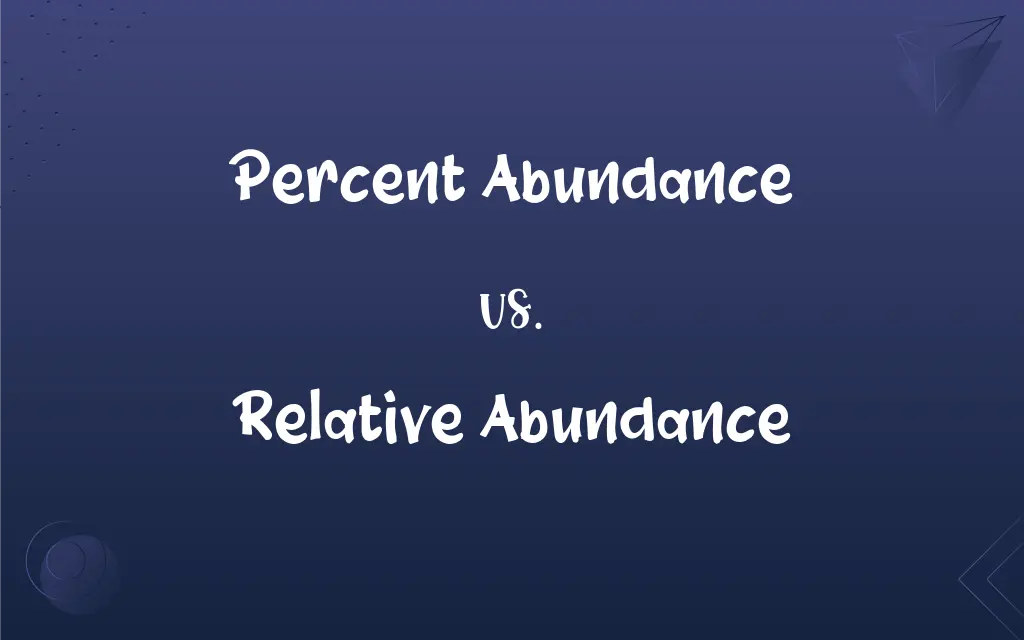Percent Abundance vs. Relative Abundance: What's the Difference?
Edited by Aimie Carlson || By Harlon Moss || Published on December 3, 2023
Percent abundance refers to the proportion of a specific isotope or element in a mixture, expressed as a percentage; relative abundance is a comparison of the abundance of different species or isotopes without a specific unit.

Key Differences
Percent abundance quantifies how much of a certain isotope is present in a natural mixture, expressed as a percentage; while relative abundance compares the presence of different isotopes or species relative to each other without necessarily using percentages.
Relative abundance is often used in ecological contexts to compare different species within an ecosystem; whereas, percent abundance, on the other hand, is typically used in chemistry to express the composition of isotopes in a sample.
In measuring isotopes, percent abundance gives a precise numerical value indicating the proportion of each isotope in a sample; relative abundance, however, might simply indicate which isotope is more prevalent, without exact percentages.
Percent abundance is crucial in calculating atomic masses of elements, as it reflects the weighted average based on isotopic composition; relative abundance is key in ecological studies to understand species distribution and ecosystem health.
Percent abundance is a specific metric that can be used in calculations, like those for atomic mass, while relative abundance provides a more general comparison, useful in qualitative analyses like understanding ecological diversity.
ADVERTISEMENT
Comparison Chart
Unit of Measurement
Expressed as a percentage.
Expressed in relative terms, no specific unit.
Primary Context
Common in chemistry for isotopes.
Used in ecology for species.
Quantitative or Qualitative
Quantitative, provides exact values.
Qualitative, focuses on comparison.
Calculation Use
Used in precise calculations like atomic mass.
Used for general comparisons, like species prevalence.
Expression of Data
Specific to one isotope or element in a mixture.
Compares multiple species or isotopes without exact percentages.
ADVERTISEMENT
Percent Abundance and Relative Abundance Definitions
Percent Abundance
The percentage representation of an isotope's presence in a natural mixture.
Understanding the percent abundance of isotopes helps in calculating atomic masses.
Relative Abundance
A term used to describe the proportional distribution of various species or isotopes in a sample.
The relative abundance of nitrogen isotopes provides clues about the ecosystem's nutrient cycles.
Percent Abundance
The proportion of a specific isotope present in a mixture, expressed as a percentage.
The percent abundance of carbon-12 in natural carbon is about 98.93%.
Relative Abundance
A measure of how common or rare a species or isotope is compared to others in the same context.
In the forest, the relative abundance of oak trees compared to pine was surprising.
Percent Abundance
The ratio of a particular isotope to the total isotopes, expressed as a percentage.
The percent abundance of deuterium in water samples varies slightly depending on the source.
Relative Abundance
The comparison of the abundance of one species or isotope to others in a given sample.
The relative abundance of a certain fish species helps assess the health of the marine ecosystem.
Percent Abundance
A metric that quantifies the proportion of a specific element or isotope in a total mixture.
The percent abundance of helium-4 in natural helium is critically important for research.
Relative Abundance
The comparative frequency or presence of different species or isotopes in a given area.
Researchers studied the relative abundance of different pollinators in the agricultural field.
Percent Abundance
A measurement indicating how much of a substance is present in a sample, in percentage.
Scientists determined the percent abundance of oxygen-16 in the sample.
Relative Abundance
The ratio of one species or isotope to another within a particular environment or sample.
The relative abundance of invasive plants in the region has increased dramatically.
FAQs
How is relative abundance different from percent abundance?
Relative abundance compares the presence of species or isotopes without specific units, unlike the percentage-based percent abundance.
What does percent abundance measure?
Percent abundance measures the proportion of a specific isotope or element in a mixture as a percentage.
What is an example of using relative abundance in ecology?
Relative abundance is used to compare different species within an ecosystem to understand biodiversity.
Can percent abundance be used for elements other than isotopes?
Yes, percent abundance can apply to any element in a mixture, not just isotopes.
Is relative abundance always less precise than percent abundance?
Relative abundance is typically less precise as it focuses on comparative, not exact, values.
How do scientists calculate percent abundance?
Scientists calculate percent abundance by determining the ratio of a specific isotope or element to the total sample, then multiplying by 100.
Can relative abundance help in understanding environmental changes?
Yes, changes in the relative abundance of species can indicate environmental shifts or impacts.
Why is percent abundance important in chemistry?
Percent abundance is crucial for calculating the atomic masses of elements based on isotopic composition.
Can percent abundance vary between different samples?
Yes, percent abundance can vary depending on the source and composition of the sample.
What role does relative abundance play in biodiversity studies?
Relative abundance helps in assessing the diversity and health of ecosystems by comparing species presence.
Does relative abundance provide information on species dominance?
Yes, relative abundance can indicate which species are more dominant or prevalent in an ecosystem.
How does relative abundance affect ecosystem management?
Knowledge of relative abundance is essential for effective ecosystem management and restoration strategies.
Can relative abundance data be misleading without context?
Yes, relative abundance data can be misleading if not considered in the context of total population sizes or environmental factors.
What tools are used to measure percent abundance?
Mass spectrometers and other analytical instruments are often used to measure percent abundance.
Is percent abundance relevant in environmental science?
Percent abundance can be relevant, especially in studies involving isotopic analysis of environmental samples.
Why is tracking relative abundance important in climate studies?
Tracking relative abundance of species helps understand the impacts of climate change on biodiversity.
Can percent abundance impact industrial processes?
Yes, variations in percent abundance can affect industrial processes like metallurgy and chemical manufacturing.
How do variations in percent abundance affect scientific research?
Variations in percent abundance can significantly impact research outcomes, especially in fields like geochemistry and materials science.
How does relative abundance contribute to conservation efforts?
Understanding relative abundance helps in prioritizing conservation efforts based on species prevalence and risk.
What challenges exist in measuring percent abundance accurately?
Accurate measurement of percent abundance can be challenging due to isotopic fractionation and sample purity issues.
About Author
Written by
Harlon MossHarlon is a seasoned quality moderator and accomplished content writer for Difference Wiki. An alumnus of the prestigious University of California, he earned his degree in Computer Science. Leveraging his academic background, Harlon brings a meticulous and informed perspective to his work, ensuring content accuracy and excellence.
Edited by
Aimie CarlsonAimie Carlson, holding a master's degree in English literature, is a fervent English language enthusiast. She lends her writing talents to Difference Wiki, a prominent website that specializes in comparisons, offering readers insightful analyses that both captivate and inform.






































































